Isolation and Gain Improvement of a Rectangular Notch UWB-MIMO Antenna
Abstract
:1. Introduction
2. Design Procedure of New UWB-MIMO Antenna
2.1. Single-Element UWB Antenna
2.2. UWB-MIMO Antenna without Decoupling Structure
2.3. UWB-MIMO Antenna with Square Shaped Decoupler
2.4. Proposed UWB-MIMO Antenna
3. Results and Discussion
3.1. Reflection Coefficients
3.2. Transmission Coefficients
3.3. Envelope Correlation Coefficient
3.4. Diversity Gain
3.5. Channel Capacity Loss
3.6. Mean Effective Gain
3.7. Comparison with State-of-Artwork
4. Conclusions
Author Contributions
Funding
Institutional Review Board Statement
Informed Consent Statement
Data Availability Statement
Conflicts of Interest
References
- Naeem, U.; Iqbal, A.; Shafique, M.F.; Bila, S. Efficient Design Methodology for a Complex DRA-SIW Filter-Antenna Subsystem. Int. J. Antennas Propag. 2017, 2017, 6401810. [Google Scholar] [CrossRef]
- Iqbal, A.; Tiang, J.J.; Lee, C.K.; Mallat, N.K.; Wong, S.W. Dual-band half mode substrate integrated waveguide filter with independently tunable bands. IEEE Trans. Circuits Syst. II Express Briefs 2019, 67, 285–289. [Google Scholar] [CrossRef]
- Lalbakhsh, A.; Mohamadpour, G.; Roshani, S.; Ami, M.; Roshani, S.; Sayem, A.S.M.; Koziel, S. Design of a Compact PlanarTransmission Line for Miniaturized Rat-Race Coupler with Harmonics Suppression. IEEE Access 2021, 9, 129207–129217. [Google Scholar] [CrossRef]
- Fontana, R.J. Recent system applications of short-pulse ultra-wideband (UWB) technology. IEEE Trans. Microw. Theory Tech. 2004, 52, 2087–2104. [Google Scholar] [CrossRef]
- Hussain, N.; Jeong, M.; Park, J.; Rhee, S.; Kim, P.; Kim, N. A compact size 2.9–23.5 GHz microstrip patch antenna with WLAN band-rejection. Microw. Opt. Technol. Lett. 2019, 61, 1307–1313. [Google Scholar] [CrossRef]
- Ramakrishna, C.; Kumar, G.A.R.P.; Sekhar, C. Quadruple Band-Notched Compact Monopole UWB Antenna for Wireless Applications. J. Electromagn. Eng. Sci. 2021, 21, 406–416. [Google Scholar] [CrossRef]
- Chen, X.; Zhang, S.; Li, Q. A review of mutual coupling in MIMO systems. IEEE Access 2018, 6, 24706–24719. [Google Scholar] [CrossRef]
- Nadeem, I.; Choi, D.Y. Study on mutual coupling reduction technique for MIMO antennas. IEEE Access 2018, 7, 563–586. [Google Scholar] [CrossRef]
- Luo, C.M.; Hong, J.S.; Zhong, L.L. Isolation enhancement of a very compact UWB-MIMO slot antenna with two defected ground structures. IEEE Antennas Wirel. Propag. Lett. 2015, 14, 1766–1769. [Google Scholar] [CrossRef]
- Masoodi, I.S.; Ishteyaq, I.; Muzaffar, K.; Magray, M.I. A compact band-notched antenna with high isolation for UWB MIMO applications. Int. J. Microw. Wirel. Technol. 2021, 13, 634–640. [Google Scholar] [CrossRef]
- Malekpour, N.; Amin, H.M.; Dadgarpur, A.; Virdee, B.S.; Denidni, T.A. Compact UWB MIMO antenna with band-notched characteristic. Microw. Opt. Technol. Lett. 2017, 59, 1037–1041. [Google Scholar] [CrossRef]
- Tang, T.C.; Lin, K.H. An ultrawideband MIMO antenna with dual band-notched function. IEEE Antennas Wirel. Propag. Lett. 2014, 13, 1076–1079. [Google Scholar] [CrossRef]
- Khan, M.S.; Iftikhar, A.; Shubair, R.M.; Capobianco, A.D.; Asif, S.M.; Braaten, B.D.; Anagnostou, D.E. Ultra-compact reconfigurable band-reject UWB MIMO antenna with four radiators. Electronics 2020, 9, 584. [Google Scholar] [CrossRef] [Green Version]
- Amin, F.; Saleem, R.; Shabbir, T.; Bilal, M.; Shafique, M.F. A compact quad-element UWB-MIMO antenna system with parasitic decoupling mechanism. Appl. Sci. 2019, 9, 2371. [Google Scholar] [CrossRef] [Green Version]
- Chen, Z.; Zhou, W.; Hong, J. A Miniaturized MIMO Antenna with Triple Band-Notched Characteristics for UWB Applications. IEEE Access 2021, 9, 63646–63655. [Google Scholar] [CrossRef]
- Kayabasi, A.; Toktas, A.; Yigit, E.; Sabanci, K. Triangular quad-port multi-polarized UWB MIMO antenna with enhanced isolation using neutralization ring. AEU-Int. J. Electron. Commun. 2018, 85, 47–53. [Google Scholar] [CrossRef]
- Iqbal, A.; Saraereh, O.A.; Ahmad, A.W.; Bashir, S. Mutual coupling reduction using F-shaped stubs in UWB-MIMO antenna. IEEE Access 2017, 6, 2755–2759. [Google Scholar] [CrossRef]
- Khan, M.I.; Khattak, M.I.; Al-Hasan, M. Miniaturized MIMO Antenna with Low Inter-radiator Transmittance and Band Rejection Features. J. Electromagn. Eng. Sci. 2021, 21, 307–315. [Google Scholar] [CrossRef]
- Jaglan, N.; Kanaujia, B.K.; Gupta, S.D.; Srivastava, S. Dual band notched EBG structure based UWB MIMO/diversity antenna with reduced wideband electromagnetic coupling. Frequenz 2017, 71, 555–565. [Google Scholar] [CrossRef]
- Najam, A.I.; Duroc, Y.; Tedjini, S. UWB-MIMO antenna with novel stub structure. Prog. Electromagn. Res. C 2011, 19, 245–257. [Google Scholar] [CrossRef] [Green Version]
- Yin, W.; Chen, S.; Chang, J.; Li, C.; Khamas, S.K. CPW fed Compact UWB 4-Element MIMO Antenna with High Isolation. Sensors 2020, 21, 2688. [Google Scholar] [CrossRef]
- Gorai, A.; Dasgupta, A.; Ghatak, R. A compact quasi-self-complementary dual band notched UWB MIMO antenna with enhanced isolation using Hilbert fractal slot. AEU-Int. J. Electron. Commun. 2018, 94, 36–41. [Google Scholar] [CrossRef]
- Sufian, M.A.; Hussain, N.; Askari, H.; Park, S.G.; Shin, K.S.; Kim, N. Isolation Enhancement of a Metasurface-Based MIMO Antenna Using Slots and Shorting Pins. IEEE Access 2021, 9, 73533–73543. [Google Scholar] [CrossRef]
- Jabire, A.H.; Ghaffar, A.; Li, X.J.; Abdu, A.; Saminu, S.; Alibakhshikenari, M.; Falcone, F.; Limiti, E. Metamaterial Based Design of Compact UWB/MIMO Monopoles Antenna with Characteristic Mode Analysis. Appl. Sci. 2021, 11, 1542. [Google Scholar] [CrossRef]
- Farahani, M.; Mohammad-Ali-Nezhad, S. A novel UWB printed monopole MIMO antenna with non-uniform transmission line using nonlinear model predictive. Int. J. Eng. Sci. Technol. 2020, 23, 1385–1396. [Google Scholar] [CrossRef]
- Abbas, A.; Hussain, N.; Jeong, M.-J.; Park, J.; Shin, K.S.; Kim, T.; Kim, N. A Rectangular Notch-Band UWB Antenna with Controllable Notched Bandwidth and Centre Frequency. Sensors 2020, 20, 777. [Google Scholar] [CrossRef] [Green Version]
- Abbas, A.; Hussain, N.; Lee, J.; Park, S.G.; Kim, N. Triple Rectangular Notch UWB Antenna Using EBG and SRR. IEEE Access 2020, 9, 2508–2515. [Google Scholar] [CrossRef]
- Hussain, N.; Jeong, M.J.; Abbas, A.; Kim, N. Metasurface-based single-layer wideband circularly polarized MIMO antenna for 5G millimeter-wave systems. IEEE Access 2020, 8, 130293–130304. [Google Scholar] [CrossRef]
- Lalbakhsh, A.; Afzal, M.U.; Hayat, T.; Esselle, K.P.; Mandal, K. All-metal wideband metasurface for near-field transformation of medium-to-high gain electromagnetic sources. Sci. Rep. 2021, 11, 9421. [Google Scholar] [CrossRef]
- Lalbakhsh, A.; Afzal, M.U.; Zeb, B.A.; Esselle, K.P. Design of a dielectric phase-correcting structure for an EBG resonator antenna using particle swarm optimization. In Proceedings of the International Symposium on Antennas Propagation (ISAP), Hobart, TAS, Australia, 9–12 November 2015; pp. 408–410. [Google Scholar]
- Jeong, M.J.; Hussain, N.; Park, J.W.; Park, S.G.; Rhee, S.Y.; Kim, N. Millimeter-wave microstrip patch antenna using vertically coupled split ring metaplate for gain enhancement. Microw. Opt. Technol. Lett. 2019, 61, 2360–2365. [Google Scholar] [CrossRef]
- Lalbakhsh, A.; Afzal, M.U.; Esselle, K.P. Multiobjective particle swarm optimization to design a time-delay equalizer metasurface for an electromagnetic band-gap resonator antenna. IEEE Antennas Wirel. Propag. Lett. 2016, 16, 912–915. [Google Scholar] [CrossRef]
- Hussain, N.; Jeong, M.J.; Abbas, A.; Kim, T.J.; Kim, N. A metasurface-based low-profile wideband circularly polarized patch antenna for 5G millimeter-wave systems. IEEE Access 2020, 8, 22127–22135. [Google Scholar] [CrossRef]


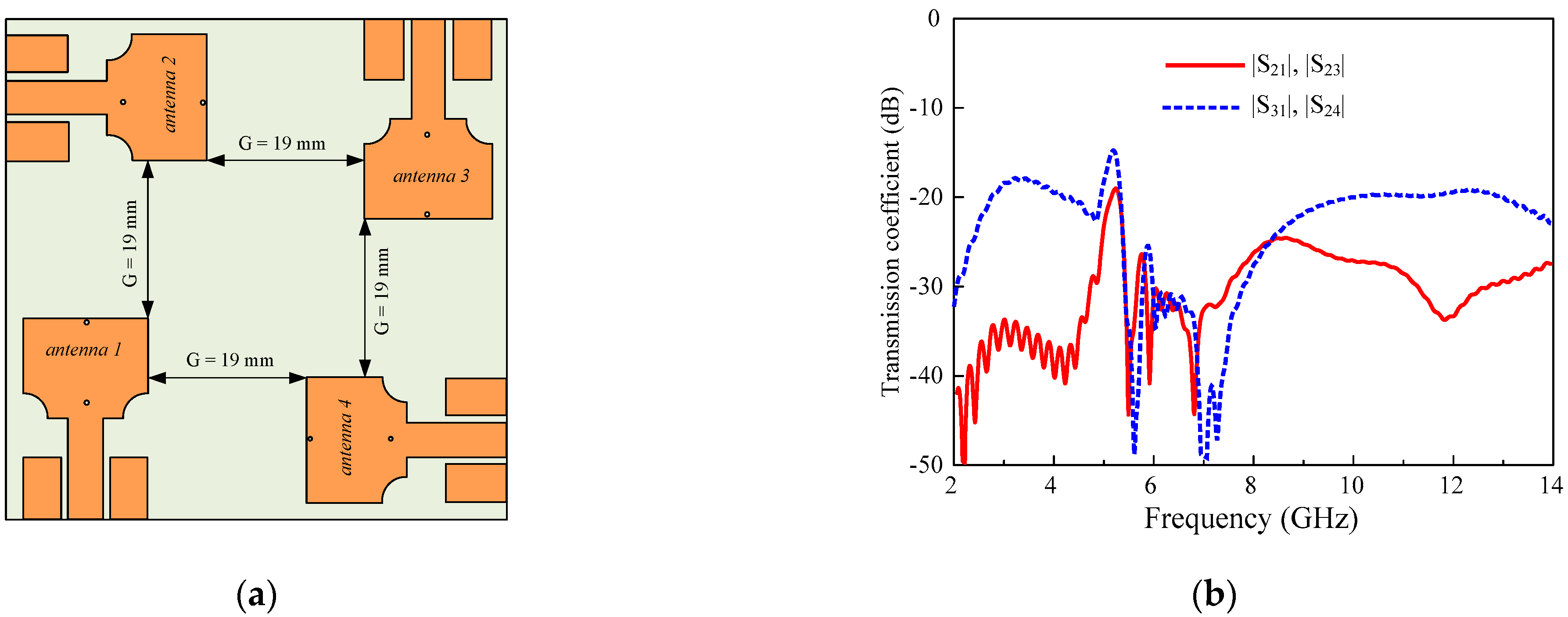
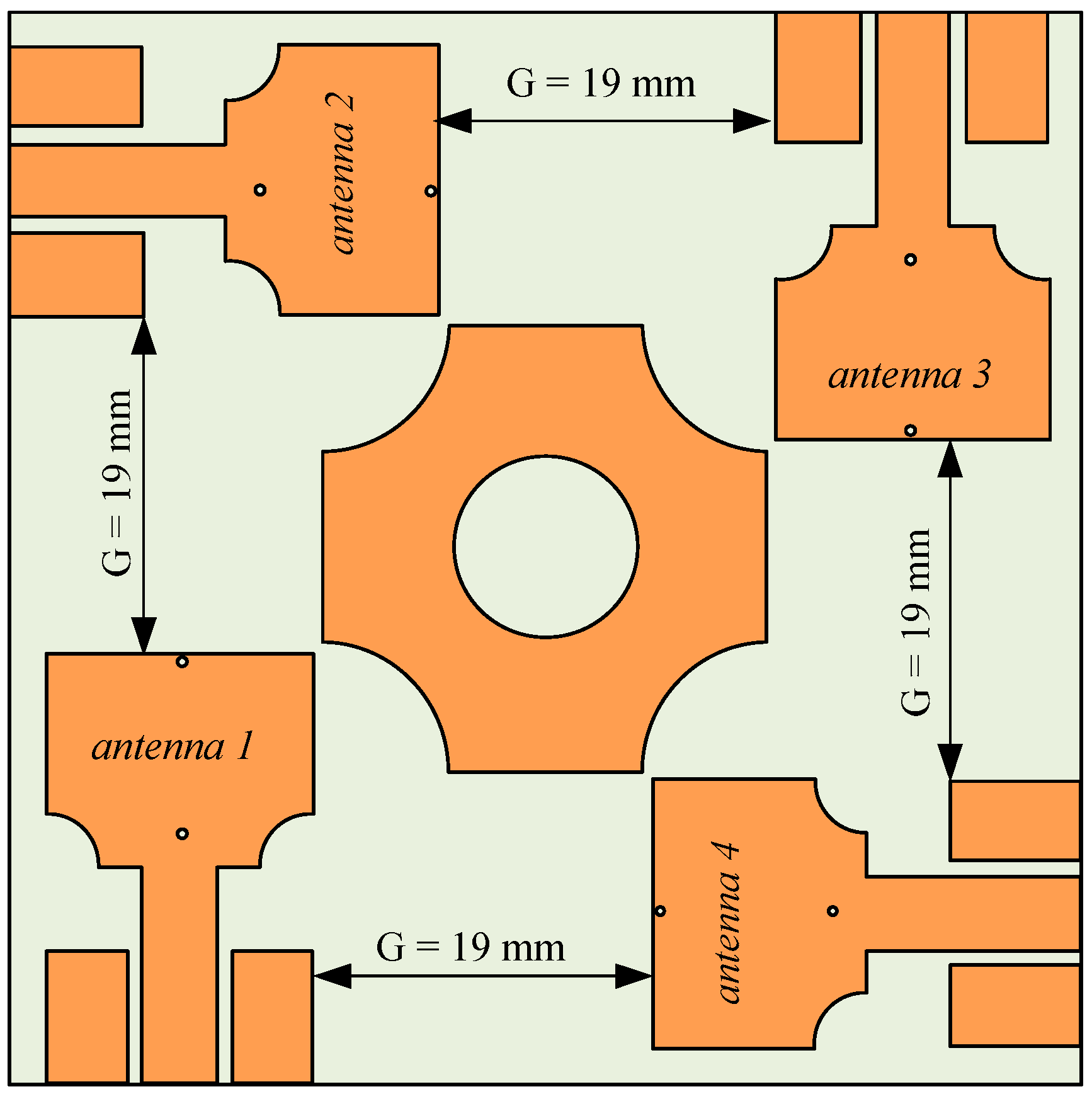


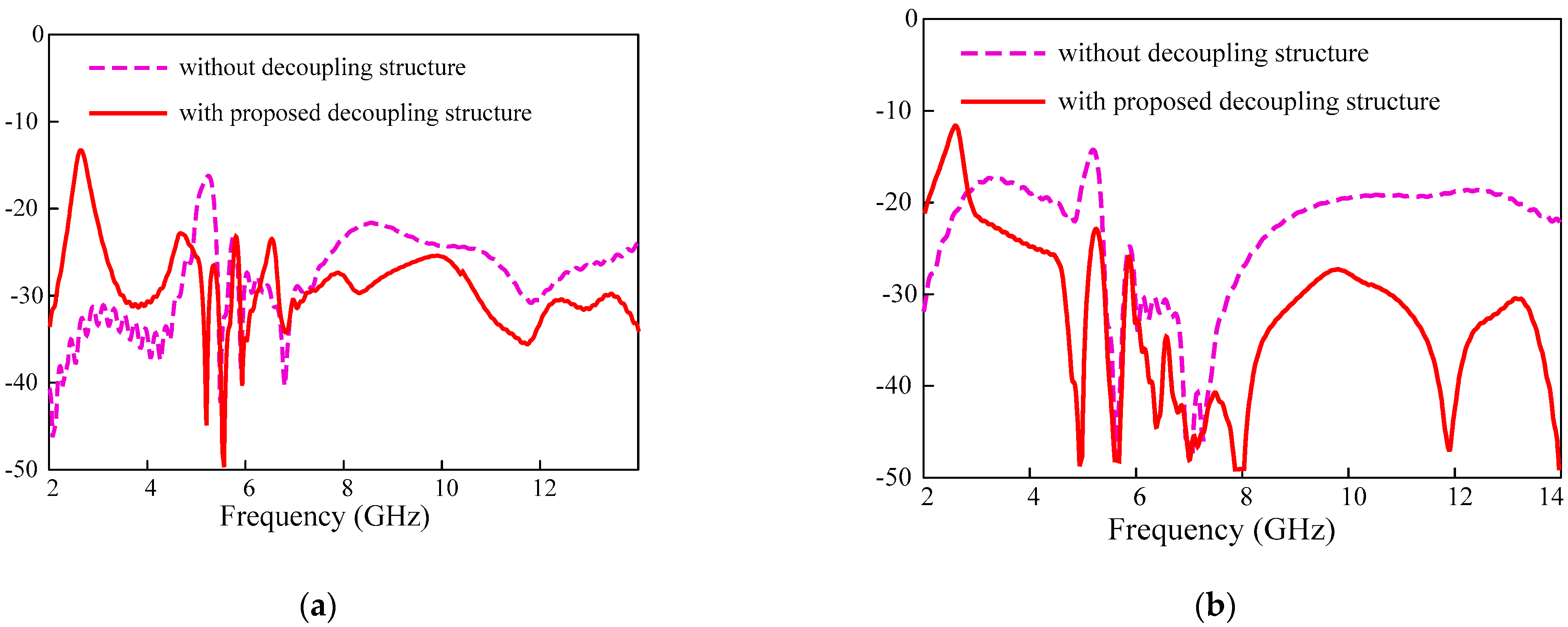


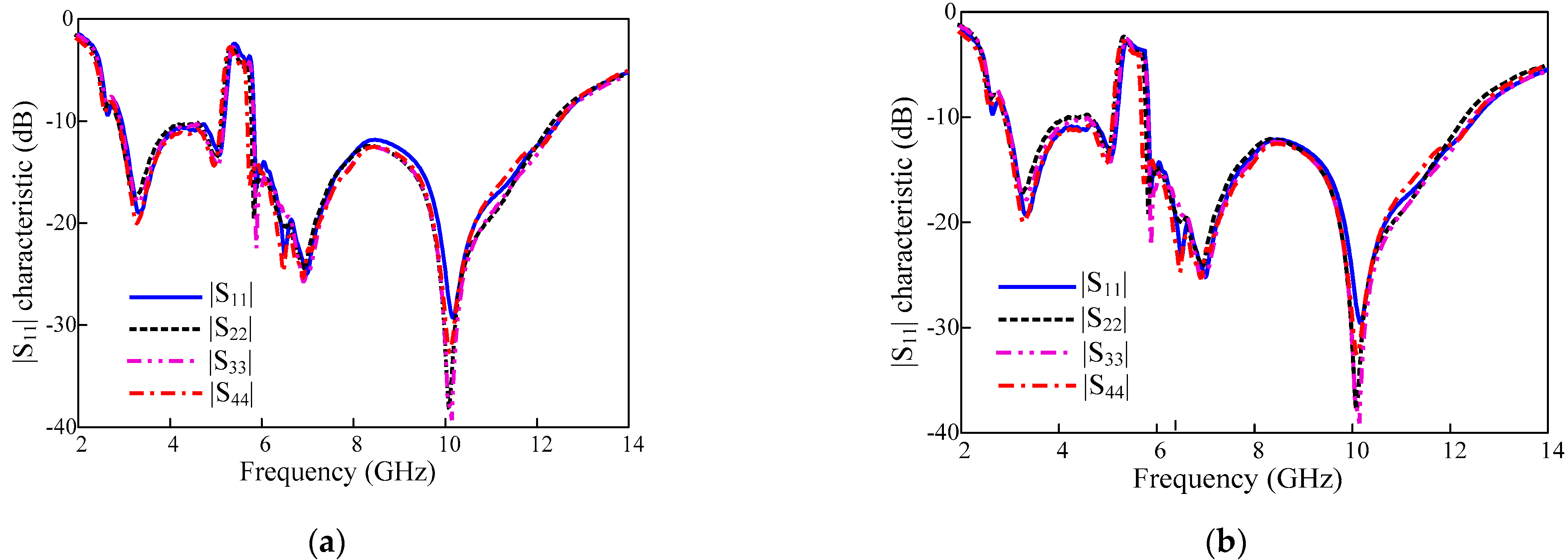
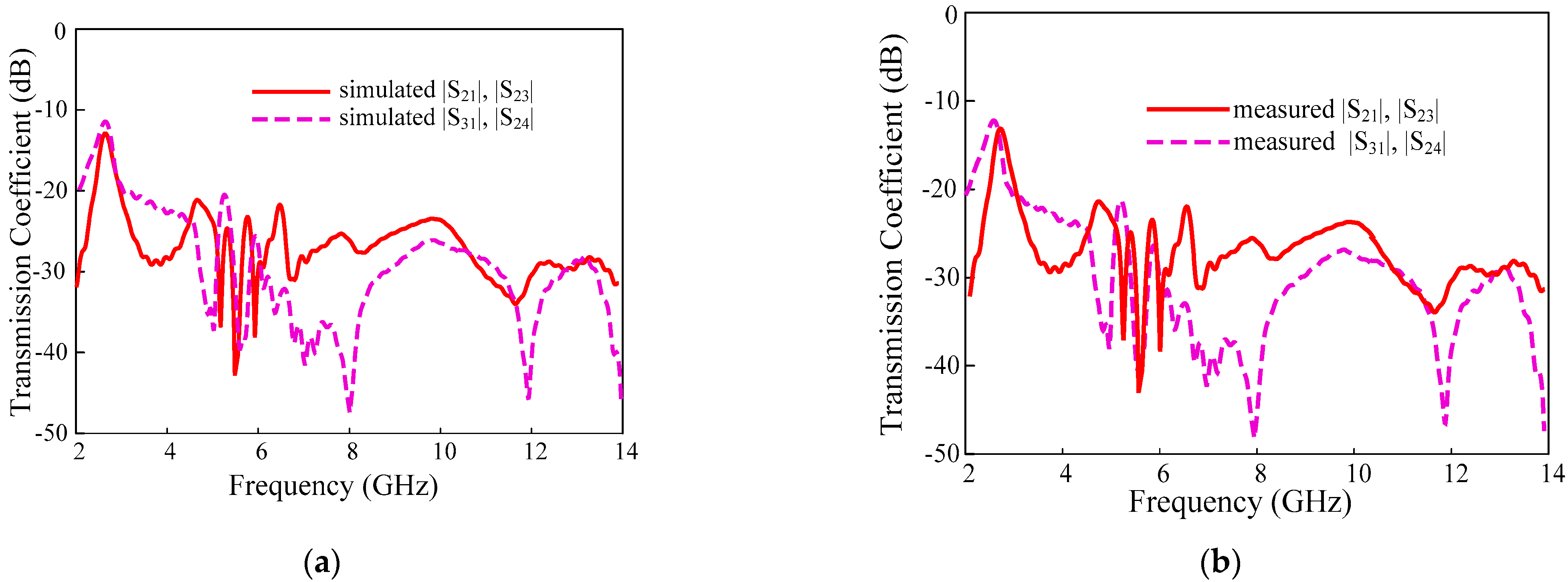
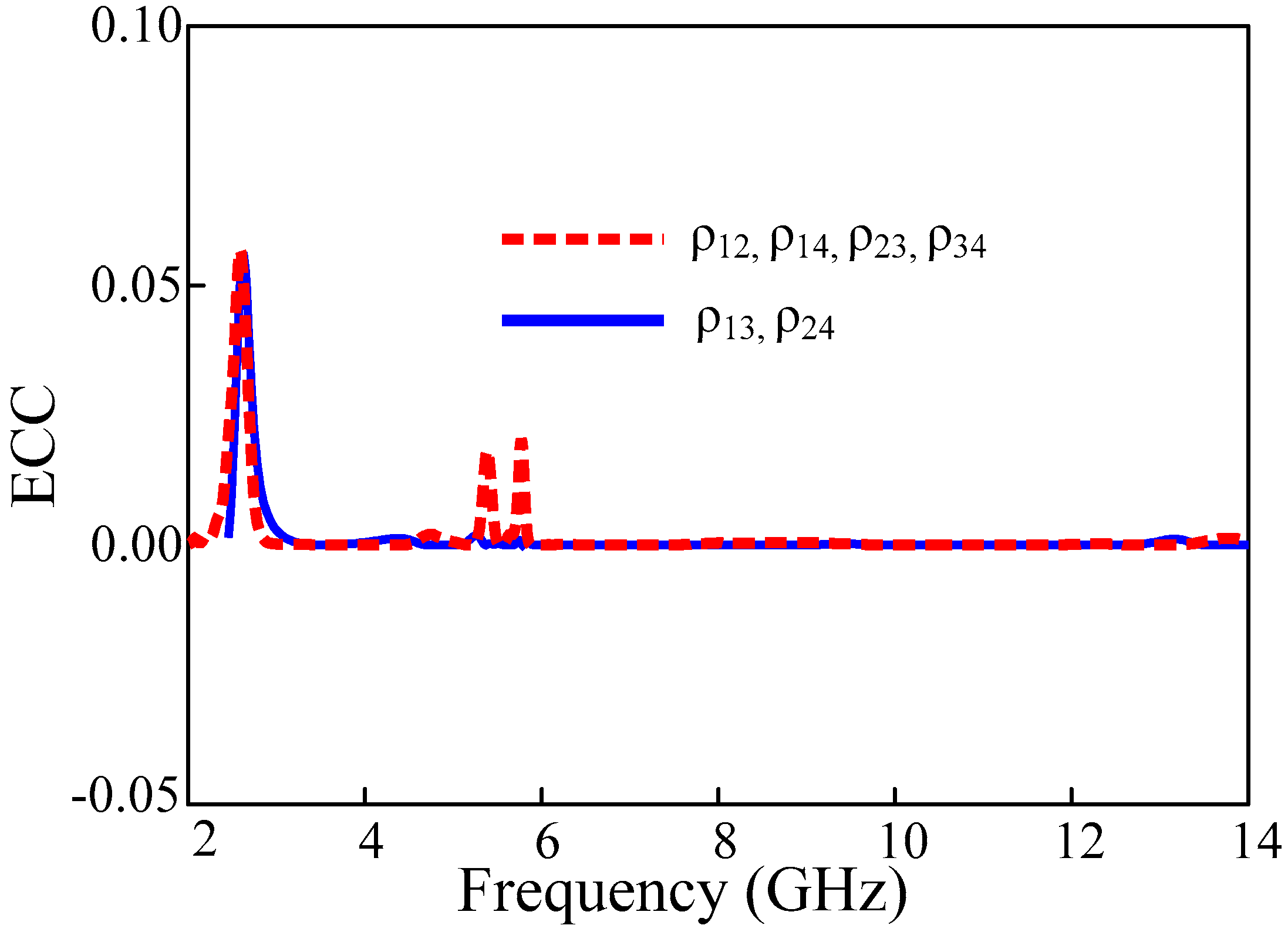
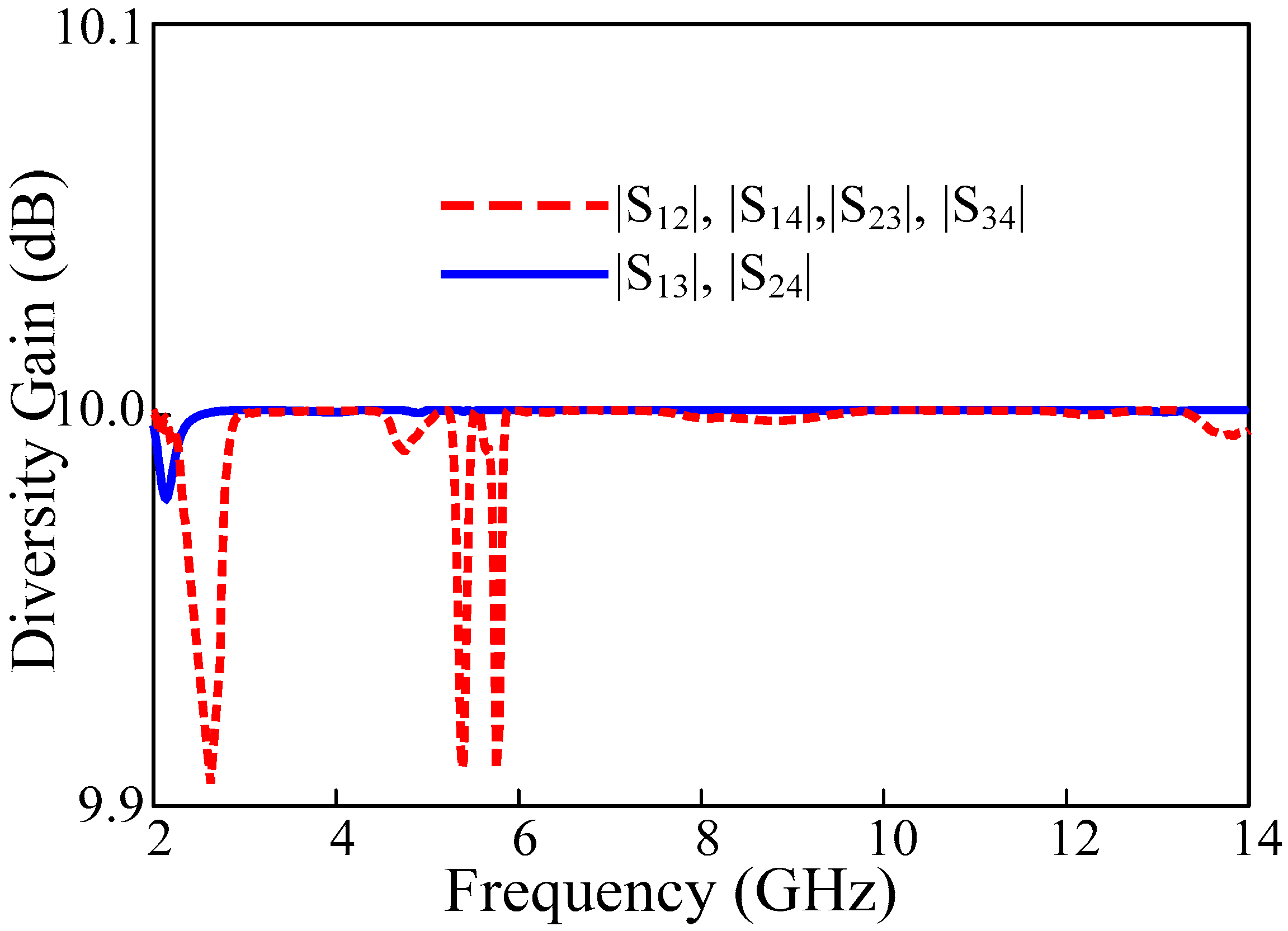
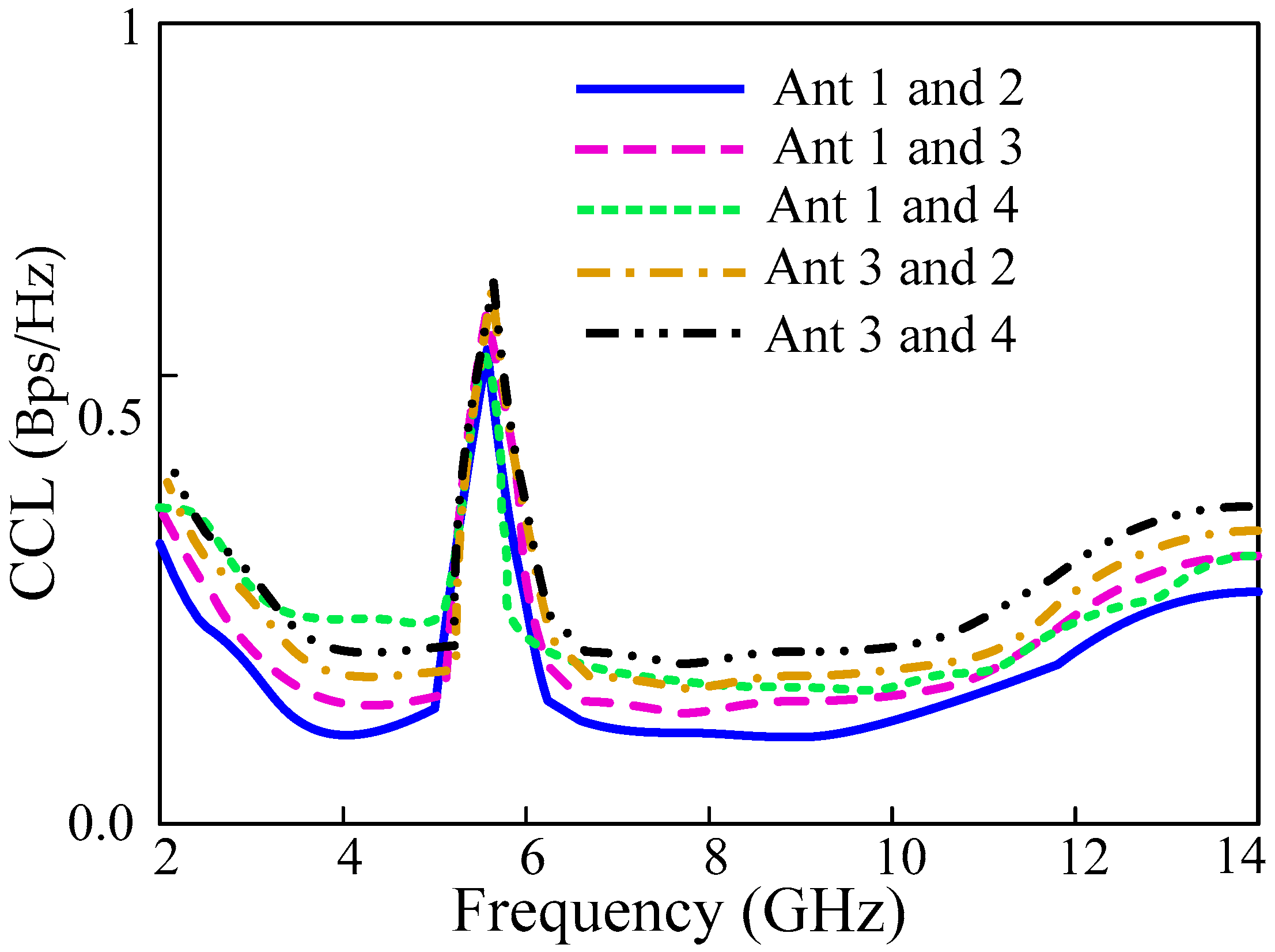
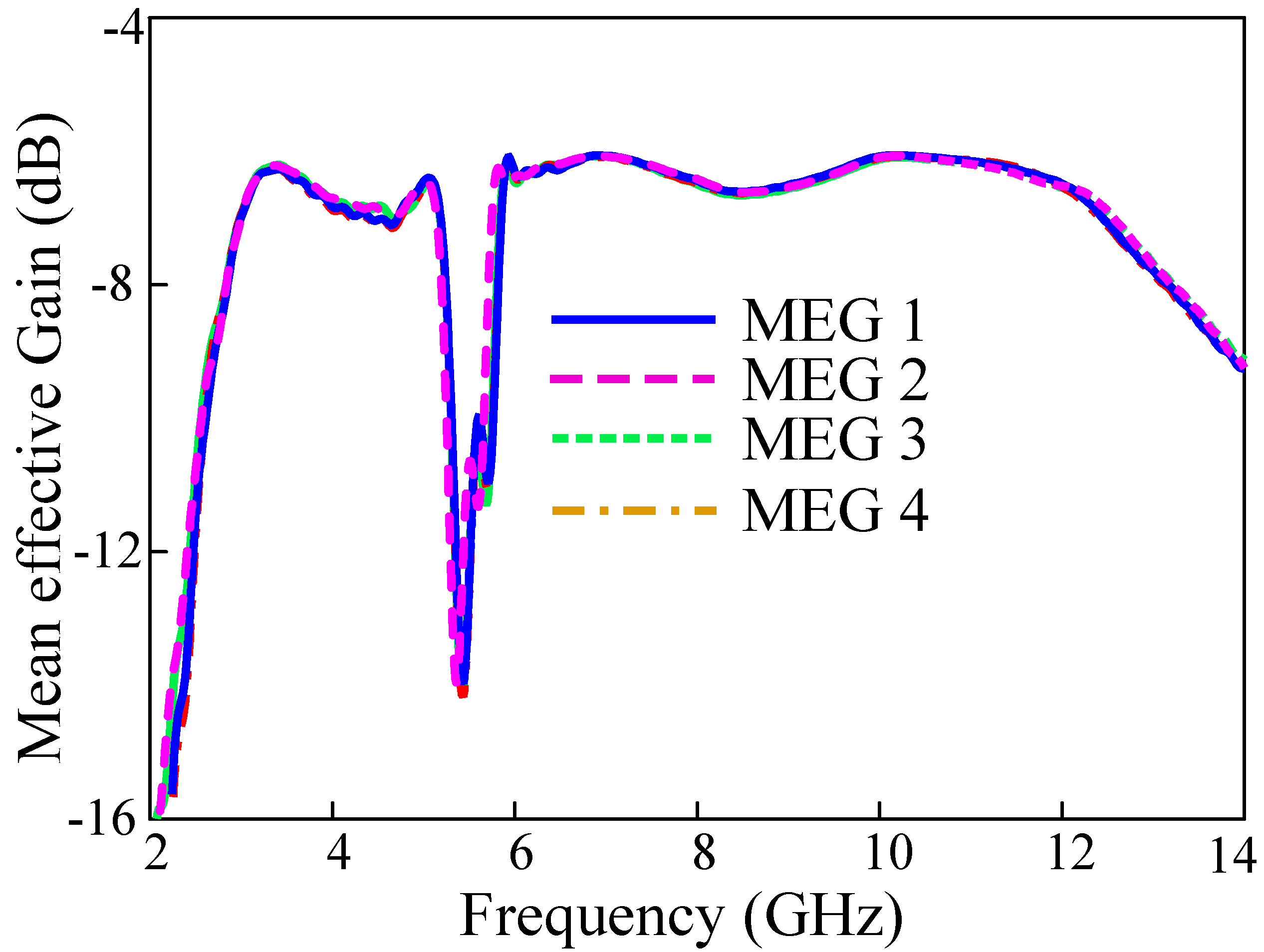
| Parameters | sw | sl | h | pw | pl | lg | fw | wd | r | l3 | l5 | l6 |
|---|---|---|---|---|---|---|---|---|---|---|---|---|
| Units (mm) | 60 | 60 | 1.5 | 15 | 12 | 7.4 | 4.1 | 0.9 | 0.3 | 20 | 10 | 4.1 |
| Parameters | w1 | w2 | l1 | l2 | s | s1 | via | l4 | r1 | r2 | l7 | w3 |
| Units (mm) | 1 | 1.8 | 15.2 | 15.2 | 3.5 | 11.3 | 0.2 | 20 | 6 | 5 | 2.9 | 3 |
| Freq (GHz) | Gain (dBi) of Antenna Element | |||||||
|---|---|---|---|---|---|---|---|---|
| Simulated Values | Measured Values | |||||||
| Port 1 | Port 2 | Port 3 | Port 4 | Port 1 | Port 2 | Port 3 | Port 4 | |
| 3 | 4.42 | 4.49 | 4.49 | 4.35 | 4.3 | 4.4 | 4.4 | 4.25 |
| 5 | 3.5 | 3.63 | 3.56 | 4.02 | 3.3 | 3.45 | 3.4 | 3.8 |
| 7 | 5.42 | 5.47 | 5.62 | 5.69 | 5.35 | 5.32 | 5.4 | 5.6 |
| 9 | 6.77 | 6.8 | 6.94 | 6.75 | 6 | 6.5 | 6.6 | 6.55 |
| Ref. | Isolation Enhancement Technique | Antenna Size (mm3) | ECC | Minimum Isolation (dB) | Peak Gain (dBi) |
|---|---|---|---|---|---|
| [10] | Defected ground | 29 × 40 × 0.508 | 0.0005 | 18 | 4.9 |
| [11] | Defected ground | 22 × 29 × 0.8 | 0.03 | 17 | 6 |
| [12] | Decoupling element | 30 × 40 × 0.8 | 0.05 | 15 | 4.2 |
| [13] | Space diversity | 25 × 50 × 1.6 | 0.43 | 17 | 3.5 |
| [14] | Parasitic decoupler | 40 × 43 × 1 | 0.2 | 20 | 4 |
| [15] | Parasitic strip | 34 × 34 × 1.6 | 0.05 | 15 | 5.5 |
| [16] | Neutralization rings | 75.19 × 75.19 × 1.6 | 0.1 | 14.5 | 5 |
| [17] | F shaped stub | 50 × 30 × 1.6 | 0.04 | 18 | 2.91 |
| [18] | Used slots | 15 × 25 × 1.6 | 0.02 | 20 | NG |
| [19] | Inverted-Y shaped stub | 58 × 45 × 1.6 | 0.02 | 15 | NG |
| [21] | Inverted-Y shaped stub | 33 × 38 × 1.6 | 0.08 | 17 | 6.2 |
| [24] | Metamaterial | 30 × 60 × 1.6 | 0.01 | 20 | 5.5 |
| This work | Parasitic decoupler | 60 × 60 × 1.52 | >0.001 | 21 | 6.94 |
Publisher’s Note: MDPI stays neutral with regard to jurisdictional claims in published maps and institutional affiliations. |
© 2022 by the authors. Licensee MDPI, Basel, Switzerland. This article is an open access article distributed under the terms and conditions of the Creative Commons Attribution (CC BY) license (https://creativecommons.org/licenses/by/4.0/).
Share and Cite
Abbas, A.; Hussain, N.; Sufian, M.A.; Jung, J.; Park, S.M.; Kim, N. Isolation and Gain Improvement of a Rectangular Notch UWB-MIMO Antenna. Sensors 2022, 22, 1460. https://doi.org/10.3390/s22041460
Abbas A, Hussain N, Sufian MA, Jung J, Park SM, Kim N. Isolation and Gain Improvement of a Rectangular Notch UWB-MIMO Antenna. Sensors. 2022; 22(4):1460. https://doi.org/10.3390/s22041460
Chicago/Turabian StyleAbbas, Anees, Niamat Hussain, Md. Abu Sufian, Jinkyu Jung, Sang Myeong Park, and Nam Kim. 2022. "Isolation and Gain Improvement of a Rectangular Notch UWB-MIMO Antenna" Sensors 22, no. 4: 1460. https://doi.org/10.3390/s22041460
APA StyleAbbas, A., Hussain, N., Sufian, M. A., Jung, J., Park, S. M., & Kim, N. (2022). Isolation and Gain Improvement of a Rectangular Notch UWB-MIMO Antenna. Sensors, 22(4), 1460. https://doi.org/10.3390/s22041460











